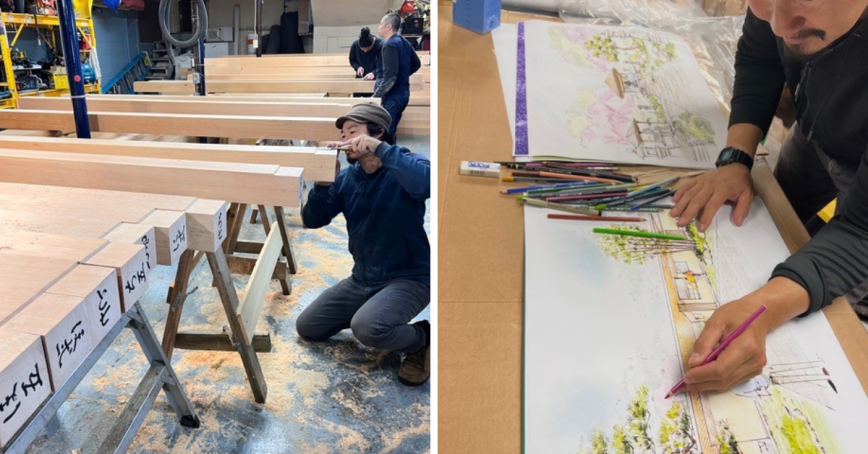Thoughtful design and carefully selected wood shapes teahouse

Any construction project is a tightly choreographed dance, with location and design, materials and budget, skills and artistry each playing critical and complementary roles.
In the case of the Japanese teahouse planned as part of the large-scale revitalization of the Japanese gardens on the campus of Royal Roads University, that choreography is notable for an acute level of precision and attention to detail.
The design must fit the environment, a historic location and the BC building code.
The construction process requires months of off-site work to prepare for on-site assembly.
And then there’s the lumber.
Hayato Ogawa, the renowned landscape designer whose Burnaby, BC company, Ogawa Landscape Design, was hired by RRU to design and build the teahouse, says every aspect of the wood used in its construction is considered: the kind of wood, yes, but also its provenance and quality.
Ogawa and associates worked with Canadian Bavarian Millwork & Lumber Ltd. in Chemainus, B.C. to sustainably source Douglas fir from old-or second-growth sources, and never from clearcuts.
“We believe that using local timber is the best way to match the local environment and create a beautiful design,” Ogawa says. “It is important to take care of the environment, so we needed to know where everything came from and where the wood was harvested.”
In addition, the Ogawa team selected each piece looking for “clear” lumber — wood with tight rings, free from defects.
“As no two pieces of wood are the same, each piece is carefully evaluated for its individual qualities and the beauty of its grain, and then used in the right place."
Hayato Ogawa
"For example, materials used near the entrance are of fine-grained wood while those used in the teahouse are of wide-grained wood… It is designed to lead people into the interior,” Ogawa explains.
The wood is kiln-dried before it’s transported to Ogawa’s workshop because “if the timber is not dry enough, it will quickly stretch and shrink, warp and crack,” he says, noting, “Teahouse architecture does not use aluminum or steel frames.”
A similar level of care went into the design, which took almost two years to complete and took into consideration the heritage nature of the campus as well as environmental considerations on-site. Ogawa says the initial design included two tearooms in one building but, because of a tree at the teahouse location, he and his team decided to design two structures, with a hiroma (large tearoom) and koma (small tearoom) connected by an exterior passageway.
Currently, Ogawa Landscape Design is in the middle of processing structural timberwork and door creations at its workshop, The next phase, commencing sometime in spring 2024, will take about six months to complete. During this time, half a dozen craftspersons will be working on site at Royal Roads. All woodworking, with the exception of the rough cuts, will be done by hand.
When the teahouse is completed, Royal Roads plans to open it for formal tea ceremonies and other community events on campus. The project has been made possible by private donations. Additional funding is still required to complete the project and bring the vision to life.
Ogawa has some thoughts on how the product of three years of exacting work will be used: “A teahouse is designed to blend into the natural surroundings and become an integral part of the natural surroundings. It would be great if it could be used not only for Japanese culture but, also, for various events. It would be great if people could enjoy a tea while looking at the beautiful garden. After that, each person should feel free to feel the space of the teahouse.”
Join us with a donation to keep good things growing! There are many ways to support the gardens at Royal Roads University.
Read more about the Japanese teahouse project and the Japanese gardens at RRU: